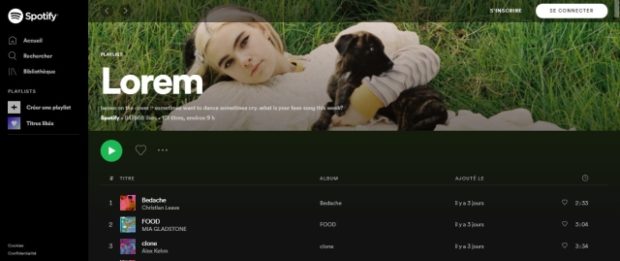
Since it launched last year, Spotify’s Lorem playlist has gained a following of loyal fans. Image: Spotify via AFP Relaxnews.
Breaking into the music industry today is no mean feat. Gone are the days when radio airplay was all it took to kickstart a career — today’s musicians have to earn their stripes on streaming sites and social media. And while that can be an arduous process, featuring in one of Spotify’s legendary playlists can prove a real career booster for artists on the make.
Take, for example, the Lorem playlist, with 181 tracks giving pride of place to songs by the likes of Christian Leave, Mia Gladstone, Oliver Malcolm, Kristiane Alphson and Charlie Burg. Unlike Spotify’s other musical selections, the songs featured on the Lorem playlist do not all belong to one same genre. It’s more about mood, billed as for listeners who “sometimes want to dance, sometimes cry.”
Despite its very vague description, Lorem seems to have found favor with a faithful audience of Gen Zers, brought up on a musical diet of the melancholy tones of Billie Eilish, Tyler, the Creator and Dominic Fyke. These young music fans have collectively spent almost 4.7 million hours listening to tracks selected by Lizzy Szabo and her team for the hit playlist, according to Hypebeast. This popularity is often echoed on Twitter, where music fans delight in the latest additions to Lorem.
“I think the younger generation today is very inclusive and accepting,” Lorem playlist curator Lizzy Szabo told Nylon. “This is not a playlist for anyone that’s taking themselves too seriously or pretentious. It’s a place where you love music; there’s no such thing as a guilty pleasure.”
Do you speak hyperpop?
While the Lorem playlist now has its own line of merchandise in trendy pastel shades, Hyperpop could be the next star playlist in line. This selection of 192 tracks features upcoming artists like osquinn, glaive and Lupa J, who draw inspiration from fields as diverse as trance, lo-fi hip-hop and dubstep, all while remaining in the pop music genre.
The exact definition of hyperpop continues to intrigue in the music business. The British singer Charli XCX even turned to Twitter to find out what it’s all about, a decision she soon regretted, leading her to say in another tweet that she does not “identify with music genres.”
what is hyperpop?
— Charli (@charli_xcx) July 22, 2020
While hyperpop is not likely to be a new record shop category any time soon, this sub-genre has managed to draw a community of over 134,000 music fans on Spotify. Although it’s nowhere near as popular as RapCaviar, with its 13.5 million followers, the Hyperpop playlist stands out for its very high number of saves for featured tracks. This could prove a real godsend for the artists, many of whom are independent.
When the money doesn’t follow
While Spotify playlists can help musicians gain popularity quickly, they do not necessarily let artists make a living from their music. The Spotify platform often comes under fire for the relatively minimal royalties it pays to the artists its 300 million users listen to, a situation that many of them decried in a petition from The Union of Musicians and Allied Workers (UMAW) and the Justice at Spotify campaign.
“Music workers create all of the enormous wealth Spotify accumulates for its CEO, its investors, and the major labels. But we artists continue to be underpaid, misled, and otherwise exploited by the company… As COVID-19 economically devastates music workers everywhere, it’s even clearer that Spotify’s existing model is counter to the needs of the vast majority of artists,” the UMAW said in a statement.
Faced with growing discontent, the Swedish giant has announced the upcoming launch of the new function called Discovery Mode. This mode, which is currently in test phase in the United States, will allow artists to identify a track that they want prioritized on the platform. In return, they have to accept a lower royalty rate for streams of the track in personalized listening sessions where Spotify has provided the service. All in all, it’s a strange kind of olive branch. CC
RELATED STORIES:
1 Spotify user out of 5 listens to podcasts
Spotify posts strong user growth despite virus fears

